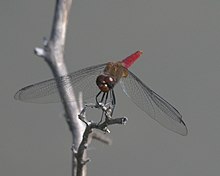| Brachymesia furcata | |
|---|---|

| |
|
Scientific classification
| |
| Domain: | Eukaryota |
| Kingdom: | Animalia |
| Phylum: | Arthropoda |
| Class: | Insecta |
| Order: | Odonata |
| Infraorder: | Anisoptera |
| Family: | Libellulidae |
| Genus: | Brachymesia |
| Species: | B. furcata
|
| Binomial name | |
| Brachymesia furcata (Hagen, 1861)
| |
Introduction
Brachymesia furcata, commonly known as the red-tailed pennant, is part of the dragonfly order Odonata. It is a species of skimmer belonging to Libellulidae, one of the largest dragonfly families in the world. Along with Brachymesia gravida and B. herbida, two closely related species within the same genus, B. furcata is often found in semi-aquatic habitats distributed throughout the Caribbean, the Americas, Argentina, West India, Mexico, and Puerto Rico. [1] [2] [3] [4] [5] [6] Current populations of B. furcata are stable. The IUCN conservation status of B. furcata designates the species as "least concern" as last reviewed in 2017. [7] [8] [9]
Life Cycle & Habitat
Similar to other dragonflies, B. furcata has a life cycle consisting of three primary stages: egg, nymph, and adult. Its eggs are laid in still-water conditions on submerged aquatic plants or directly into the water depending on the environmental conditions. Marshes, ponds, lakes, and other mildly saline aquatic habitats are all potential locations for dragonflies to colonize. [10] Bottom debris and aquatic vegetation provide both sustenance as well as hiding spots for the newly hatched dragonfly nymphs. [10] After undergoing a few molts, the nymph transitions to adulthood. As an adult, B. furcata still inhabits a semi-aquatic environment where it feeds on small flying insects such as flies or mosquitoes. Generation time for an entire life cycle is known to be fast but exact intervals are likely to depend on the specific local environmental setting. [10]
Appearance
Egg Stage
An adult female dragonfly can lay up to hundreds of eggs in batches within its lifetime. The eggs of B. furcata appear elongate and are encased in a jelly-like substance. [11]
Nymph Stage
Freshly hatched nymphs live in subaquatic habitats until they become adult dragonflies. Their physical appearances differ greatly from their adult forms starting from the obvious lack of wings. Nymphs have six long legs, which help them navigate their underwater environment. They have compound eyes and a rounded head that is nearly as wide as their thorax. [10] Nymphs of all dragonfly species in the genus Brachymesia look nearly identical. [10]
Adult Stage
Adult dragonflies have contiguous eyes and four separate wings. Compared to their nymph form, adults have a thinner abdomen that is slightly thicker around the thorax. [11] As implied by their common name, B. furcata adults have an obviously red tail that distinguishes them from other dragonflies within the same genus. [10]
Environmental concerns
Although B. furcata is relatively safe from extinction, populations are affected by anthropogenic interference. Ivermectin, a medication used to treat cattle parasites, was found in detectable concentrations within B. furcata larvae along the Parana Medio River. [12] Adverse effects on the species have yet to be observed.



References
- ^ Lozano, F.; del Palacio, A.; Ramos, L.; Muzón, J. (2020-04-02). "The Odonata of Argentina: state of knowledge and updated checklist". International Journal of Odonatology. 23 (2): 113–153. doi: 10.1080/13887890.2020.1737585. ISSN 1388-7890.
- ^ Meurgey, François (2013). "A catalogue of the West Indian dragonflies (Insecta: Odonata)". Annales de la Société entomologique de France. Nouvelle Série. 49 (3): 298–334. doi: 10.1080/00379271.2013.848066. ISSN 0037-9271.
- ^ Novelo-Gutiérrez, Rodolfo; Gómez-Anaya, José Antonio (2008-12-12). "A comparative study of Odonata (Insecta) assemblages along an altitudinal gradient in the sierra de Coalcomán Mountains, Michoacán, Mexico". Biodiversity and Conservation. 18 (3): 679–698. doi: 10.1007/s10531-008-9533-y. ISSN 0960-3115.
- ^ Paulson, Dennis R.; de Haseth, Carel; Debrot, Adolphe O. (2014-10-02). "Odonata of Curaçao, southern Caribbean, with an update to the fauna of the ABC islands". International Journal of Odonatology. 17 (4): 237–249. doi: 10.1080/13887890.2014.981877. ISSN 1388-7890.
- ^ Ramírez, Alonso; Maldonado-Benítez, Norman; Mariani-Ríos, Ashley; Figueroa-Santiago, Javier (2020-10-01). "Dragonflies and damselflies (Odonata) from Puerto Rico: a checklist with notes on distribution and habitat". PeerJ. 8: e9711. doi: 10.7717/peerj.9711. ISSN 2167-8359. PMC 7533059. PMID 33062409.
- ^ Renner, Samuel; Dalzochio, Marina Schmidt; Périco, Eduardo; Sahlén, Göran; Suhonen, Jukka (2020). "Odonate species occupancy frequency distribution and abundance–occupancy relationship patterns in temporal and permanent water bodies in a subtropical area". Ecology and Evolution. 10 (14): 7525–7536. doi: 10.1002/ece3.6478. ISSN 2045-7758. PMC 7391549. PMID 32760546.
- ^ "Brachymesia furcata: Paulson, D.R." IUCN Red List of Threatened Species. 2016-05-05. doi: 10.2305/iucn.uk.2017-3.rlts.t49254421a49255753.en. Retrieved 2021-05-08.
- ^ "Odonata Central". www.odonatacentral.org. Retrieved 2021-05-08.
- ^ Kimmins, Douglas Eric (1969). "A list of the type-specimens of Odonata in the British Museum (Natural History) Part II". Bulletin of the British Museum (Natural History). 23: 287–314. doi: 10.5962/bhl.part.15135. ISSN 0524-6431.
- ^ a b c d e f Tennessen, Kenneth J. (2019). Dragonfly Nymphs of North America. doi: 10.1007/978-3-319-97776-8. ISBN 978-3-319-97775-1.
- ^ a b KIRBY, W. F. (2010-07-07). "XIII. A Revision of the Subfamily Libellulinœ, with Descriptions of New Genera and Species". The Transactions of the Zoological Society of London. 12 (9): 249–348. doi: 10.1111/j.1096-3642.1889.tb00016.x. ISSN 0084-5620.
- ^ Mesa, Leticia; Gutiérrez, Ma. Florencia; Montalto, Luciana; Perez, Vanina; Lifschitz, Adrián (2020). "Concentration and environmental fate of ivermectin in floodplain wetlands: An ecosystem approach". Science of the Total Environment. 706: 135692. Bibcode: 2020ScTEn.706m5692M. doi: 10.1016/j.scitotenv.2019.135692. hdl: 11336/145360. ISSN 0048-9697. PMID 31826804.
Further reading
- Kalkman, V. J. (2013). Studies on phylogeny and biogeography of damselflies (Odonata) with emphasis on the Argiolestidae (PhD). Leiden University. hdl: 1887/22953.
External links
-
 Media related to
Brachymesia furcata at Wikimedia Commons
Media related to
Brachymesia furcata at Wikimedia Commons
